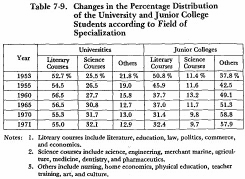- 現在位置
- トップ > 白書・統計・出版物 > 白書 > JAPAN'S MODERN EDUCATIONAL SYSTEM > (3)The Development of Faculties and Departments
(3)The Development of Faculties and Departments
The growth of the university system is also reflected in the number of new faculties and departments that were introduced after 1952, resulting in changes in the percentage distribution of students according to field of specialization (See Table 7-9.). Two separate campaigns, launched in 1957 and in 1961, to attract students into the science and engineering field resulted in the addition of new departments such as electronics and nuclear energy to the existing courses of mechanics, electrical engineering, chemistry, civil engineering, and architecture. Departments created later to deal with urban and pollution problems included urban planning and environmental engineering. The dawn of the so-called "age of information" created the need for communications experts and hence recently several departments have been established in this field.
Table 7-9. Changes in the Percentage Distribution of the University and Junior College Students according to Field of Specialization

In the humanities, new courses which have been introduced include the study of humanity, the study of human relations, the study of international relations, library science, and information science. General agriculture departments, which had been established at twelve national universities during the1953 academic year; were reorganized between 1963 and 1967 (except one reorganized in 1959) into separate departments for agricultural engineering, agricultural economy and others in order to correspond more accurately to the agricultural reforms that were in progress under the Basic Law for Agriculture.
Three noteworthy measures were taken during this period with regard to medical and dental education. The first was the establishment in April, 1955, of a regular two-year premedical course within the universities followed by four years of actual medical or dental training. This change was made by a revision of the School Education Law, which was promulgated on March31, 1954,and put in force on April l, 1955.
A second improvement was the revision of the practical training system which had been in force since 1946. The original training system, which required completion of an internship period before the medical trainee was eligible to take the state medical qualifying examination, was heavily criticized for the problems it created in the treatment, status, and guidance of medical trainees. Hence, a revision of the 1948Medical .Practitioners Law was promulgated on May 15, 1968,and put in force on that day so as to allow medical students to take the state examinations immediately upon graduation; and the compulsory internship was replaced with a voluntary clinical training system.
The third important development has been the recent establishment of new universities or faculties for medicine and dentistry. The increased demand for medical services, in combination with the maldistribution of trained medical personnet in the country, led to the foundation between 1970 and 1972 of seven private medical universities and the creation of five new faculties of medicine (one national and four private). A total of twenty universities and faculties increased their individual annual admissions quotas and the overall annual admissions quota was raised to 5,600, an increase of 1,500 students per year. In the case of dentistry, six private dental universities and nine dental faculties (five national and four private) have been created since 1961; the annual admissions quota has been raised to 2,060, an increase of 1,410. Despite these developments, however, there is still a need to improve the medical and dental training programs in order to facilitate a general improvement of the Japanese medical care system.
お問合せ先
(C)COPYRIGHT Ministry of Education, Culture, Sports, Science and Technology
-- 登録:平成21年以前 --